Thai Woman Street Food Ad Funny
Fried, flamed, frozen, grilled, stewed, and stir-fried – Thai street cooking uses fresh local seasonal ingredients and has delicious and sometimes very unusual regional specialties.
In this article, you'll get a beginner's guide to the 27 simply irresistible Thai street foods, their main ingredients, and where you can try them.
- What's the difference between Thai Food and Thai Street Food?
- What are the Key Ingredients in Thai Food?
- The Best 27 Traditional and Popular Thailand Street Foods
- Gai Tod (Fried Chicken)
- I-dtim Ma Prao (Coconut Ice Cream)
- Kai Jeow (Thai Omelet)
- Kao Niew Ma Muang (Mango Sticky Rice)
- Khanom Krok
- Khao Kha Moo
- Khao Pad (Fried Rice)
- Khao Soi
- Kluay Tod
- Laab
- Malang Tod (Fried Insects)
- Massaman Gai (Massaman Curry)
- Moo Ping
- Moo Satay (Pork Satay)
- Nam Tok Neua (Beef Waterfall Salad)
- Pad Kra Pao
- Pad See Eiw
- Pad Thai
- Pla Muek Yang (Thai Charred Squid)
- Poh Pia Tod (Spring Rolls)
- Roti
- Som Tam (Green Papaya Salad)
- Tom Kha Gai (Chicken Galangal Soup)
- Pak Boong Fai Deng (Morning Glory over Red Flame)
- Sai Krok Isan (Thai Sausage)
- Tod Mun Pla (Deep Fried Fish Cakes)
- Tom Yum Goong (Hot Shrimp Soup)
- Further Resources
This article may contain compensated links. Please read the disclaimer for more info
What's the difference between Thai Food and Thai Street Food?

Thai people, like most Asian people, love buying their evening meals from Asian street vendors. This is different from the 'western' view where time spent cooking is often a way to show love and care.
When I had young children and worked full time, I read a wonderful ethnography from an anthropologist of Thailand. She explained that Thai recipes and methods of cooking at the street food stalls are pretty much the same as how the same dish is prepared in Thai homes.
It is common in Thai culture for women to stop by street food vendors on their way home from work and carried their purchases home in plastic bags, becoming known as "plastic bag mothers."

Food is certainly about love and caring for westerners, but it doesn't have to mean we need to spend forever in the kitchen cooking up a storm to show people how much we love them.
And my kids still love it when I bring home a plastic bag full of spicy food!
What are the Key Ingredients in Thai Food?
Thai street food dishes use local and seasonal ingredients such as seafood, river fish, and tropical fruits, but there are some staple foods and flavors you'll encounter in many Thai restaurants and at your local street corner. These include:
- fish sauce
- coconut milk
- chili peppers
- rice flour
- lime juice
- palm sugar
- rice noodles
- bean sprouts
- sticky rice
- dark soy sauce
- wheat noodles
- kaffir lime leaves
The Best 27 Traditional and Popular Thailand Street Foods
So, what is Thai street food? It's surprisingly hard to tell as Thai street snacks and authentic Thai street food recipes are often served in restaurants and are also found as Thai market food!
Below you'll find some of the most famous Thai street food.
Gai Tod (Fried Chicken)

Gai Tod or fried chicken is ubiquitous in Thailand. Some Thai Chefs (like Akkapong "Earl" Ninsom) of Portland, trace the craze back to the innovations of a Muslim street vendor in the Southern Thai city of Hat Yai around forty years ago.
Gai Tod Decha (first a pushcart and now an established restaurant) pioneered the sale of Southern fried chicken so beloved in the United States with his own Southern Thai twist. Gai Tod is usually marinated in some mixture of garlic, coriander, and fish sauce.
The chicken pieces are then floured and deep-fried in a way much more familiar to Western visitors, though it often turns a little drier than the KFC Westerners are used to.
Gai Tod is often served with fried shallots, which add an important fragrance to the chicken, and is usually dipped in a chili sauce for that extra zing of flavor. Grab a couple of pieces of Gai Tod for a quick snack on the go or opt for a side dish of rice if you're looking for a more substantial meal.
Although a relatively new innovation, Gai Tod is hard to avoid in the Thailand of today, much to the delight of locals and tourists alike.
I-dtim Ma Prao (Coconut Ice Cream)
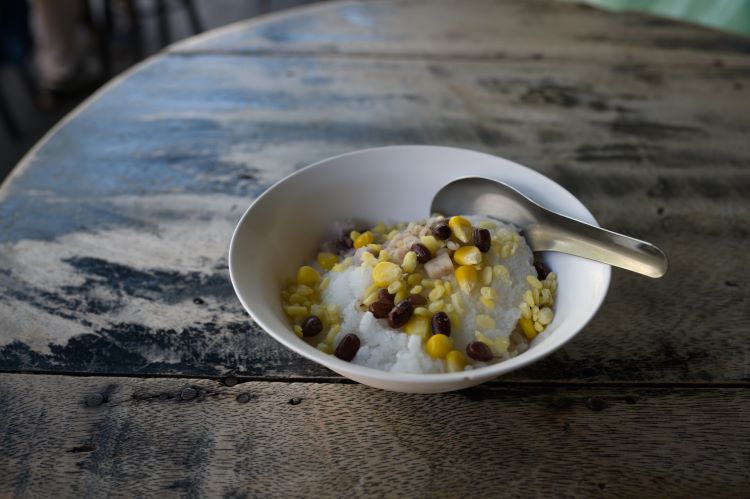
Thailand is a tropical country. There's no cool time of the year where you can escape the heat.
The temperatures in the capital average out above 30 degrees Celsius all year round. And so, in the heat of a Bangkok noon, with the humidity feeling like it's 100%, you might not exactly feel like a piping hot curry.
Don't worry, the Thai street food vendors have got you covered.
If you're feeling hot and sweaty, make a beeline for some coconut ice cream. Made from rich coconut cream instead of cow's milk, Thai coconut ice cream is a distinctly tropically twist on a dessert we all know and love. Typically served inside the husk of fresh coconut, with chunks of coconut flesh as base and topping, Thai coconut ice cream is highly customizable. Scoops of ice cream are often (unsurprisingly) topped with peanuts, but sweet corn, sticky rice, jelly, and dashes of flavored syrup are also common.
Walking around Thailand's busy streets with your very own coconut heaven in hand is a great way to adjust to the tropics. It's sure to leave a sweet and cool taste in your mouth on your adventures throughout the country.
Kai Jeow (Thai Omelet)

Though lesser known in the West, Khao Kai Jeow is another dish you'll find all throughout Thailand. A simple and quick comfort food, Kai Jeow is notoriously cheap along the roadside and a common side dish for larger meals.
Cooked at a low temperature to ensure a thin and fluffy texture, Kai Jeow combines the ever-present fish sauce with a few common spices like black pepper, chili, and garlic to give the omelet a simple wholesome profile.
Kai Jeow is typically made with pork mince, which is blended with the egg mixture to make a final product that perfectly integrates and balances the omelet's key ingredients. Shallots, peanuts, and chili flakes are often served or over the top of the omelet according to taste. A bed of rice or a side of wok-tossed vegetables are often placed on the side for those looking for more than a quick snack.
Though it can be eaten at all times of the day, Kai Jeow is also a popular breakfast food, making a great protein-packed way to start a day of adventuring.
Kao Niew Ma Muang (Mango Sticky Rice)
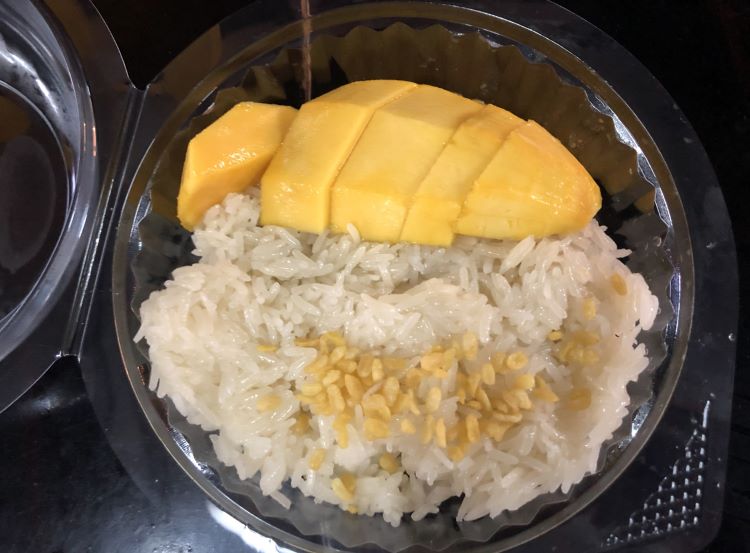
Mango Sticky Rice, or "Khao niao mamuang" in Thai, belongs to one of the most beloved street desserts in Thailand and around Southeast Asia.
It's simple to make and has won the hearts of locals and tourists alike. The centerpiece is slices of a freshly cut mango. A bowl of glutinous coconut-flavored rice completes the ultimate marriage of flavors.
The special glutinous rice needs to be steamed and then hot coconut milk is mixed in with a dash of salt and quite a bit more sugar, but otherwise nothing else. The resulting dessert is then served with sweetened and thickened coconut milk sauce and fried mung beans. Often the dessert is so filling it can replace a meal!
You can find mango sticky rice all over Thailand, from Bangkok to the islands in the South such as Koh Phangan (I loved having mine repeatedly at the Phantip market).
Since tourists love it so much, you can be sure to find it in any area popular among tourists. Mango harvest in Thailand happens in April and May, so that's also the time when you have the freshest and most delicious mangos for your mango sticky rice dessert.
I've seen mango sticky rice being sold for as little as 40 baht and well over 100 baht – depending on if you have it at a small local market, in a touristy area, or in a fancy restaurant. Mango sticky rice has transcended the street food culture and made its way to higher gastronomy too.
by Veronica Primm at Travel Geekery
Khanom Krok
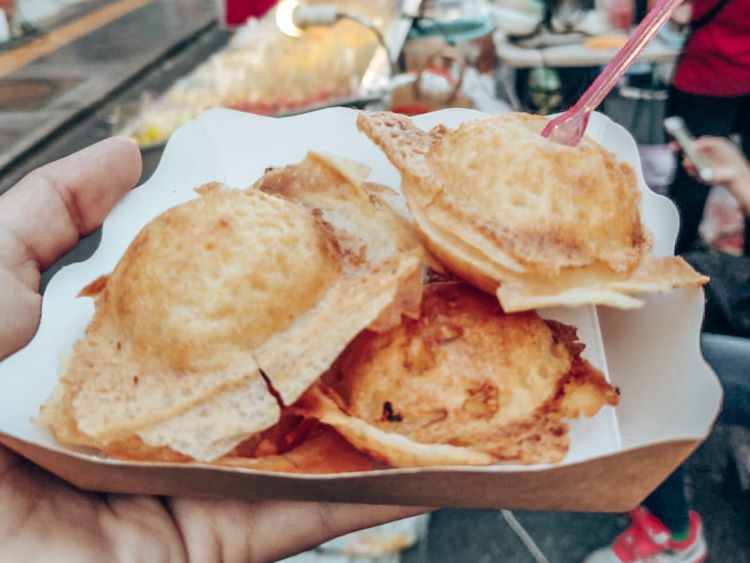
In a country known for its lip-smacking savory street food dishes, there is one much sweeter snack that takes its place alongside mango sticky rice as an ideal Thai dessert.
That'sKhanom Krok, known better to visitors simply as Thai coconut pancakes. These delectable little 'balls', can be found in nearly all markets across the country – from the upmarket King's markets of Or Tor Kor in Bangkok to the local night markets of Phuket, or the more ramshackle stalls of islands like Koh Tao or Koh Samui. These marvelous miniature pancakes are made of a simple mix – concocted out of rice flour, sugar, and coconut milk.
They are fashioned into two 'halves'; one salty and one sweet before being carefully poured into a red hot frying pan specially designed with large indents to house these circular concoctions.
The result? A crispy on the outside, yet delightfully soft on the inside ball of delight!
While the origins of the famous street eat are relatively unknown, it is said that they have been around since the 1300s, and have been virtually unchanged over time.
Nowadays you might find a few new toppings or flavorings, from South East Asia's favorite essence, pandan, to chopped-up cilantro, sugary sweetcorn bits, or the nutty taro root housed in the gooey center of the snack.
by James Scrivener at The Travel Scribes
Khao Kha Moo

One of the best Thai street foods is Khao Kha Moo, a delicious Thai-style pork leg dish served over rice. It's famous around Thailand for its rich flavor, simmered with meat broth, soy sauce, sugar, and spices.
The food in Chiang Mai is some of the best in Thailand and it's also a fantastic place to try Khao Kha Moo.
The vibey Chang Phuak Gate Night Market has been put on the map by the visit of Anthony Bourdain during the filming of Parts Unknown.
The vendor serving pork leg rice is the Cowboy Hat Lady known for her iconic hat which is always visible above the market crowds. Served with a soft-boiled egg, the portion of Khao Kha Moo is a bargain at 30 THB for a small or 50 THB for a large.
Dine on a plastic stool and rub shoulders with the locals.
by Rose Munday from Where Goes Rose
Khao Pad (Fried Rice)
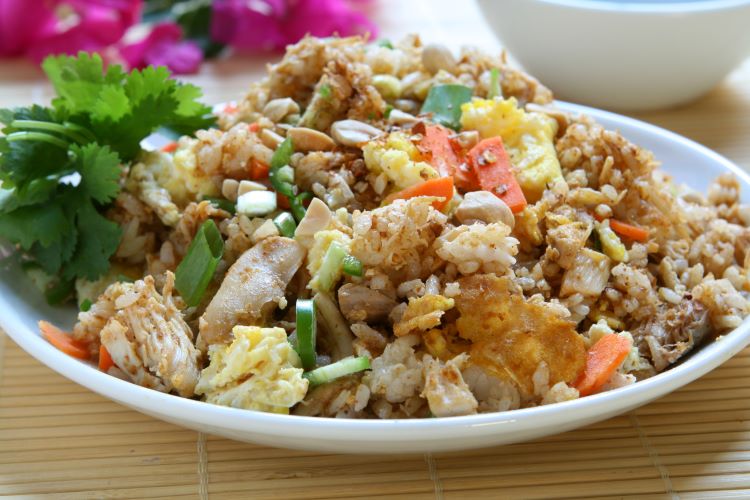
A global favorite, Thai fried rice packs a little more of a punch than the Chinese variety.
Jasmine rice gives Khao Pad its fantastic aroma and it is mixed with the main flavors of Thai cuisine such as soy and fish sauce, salt and sugar, and of course, a range of fresh seasonal and local vegetables.
Found all over Thailand, Khao pad is highly customizable – with or without meat, a variety of meats, seafood, or simply vegetables – once it's on a plate a wedge of lime is added. It is usual to eat Khao Pad with prik nam pla – a fish sauce and chili condiment.
Khao Soi

If your Thailand travels take you to the country's north, one Thai street food you absolutely cannot miss iskhao soi. Especially popular in Chiang Mai, khao soi is a rich, spicy noodle dish. The recipe originated in Southern China and was introduced by Muslims who emigrated to Myanmar from Yunnan province – hence why you can also find the dish in northern Myanmar.
The hallmark of a good khao soi is the broth: a heady, deeply spiced 'soup' made from red curry paste and turmeric. Soft noodles are submerged in the broth along with some greens and protein, most often a chicken leg or minced pork.
The bowl is then topped off with a handful of flash-fried, crispy noodles. It's the combination of soft and crunchy noodles that gives khao soi its moreish texture.
A small dish of pickled cabbage, shallots, and a wedge of lime is typically served on the side, along with the usual table condiments (chili, sugar, peanuts, shallots) that you can add to achieve your desired taste.
It's customary to toss everything together with your chopsticks before diving in. Chiang Mai is the spiritual home of khao soi – it's ubiquitous on restaurant menus and you can find it at most street food markets.
One of the best places to try it is at Khao Soi Mae Sai, a no-frills local favorite that specializes in the dish. A bowl of khao soi will set you back 40 Thai baht (approximately $1.20), making it one of the best affordable, authentic lunch options in the city.
by Emily Lush at Wander-Lush
Kluay Tod

The mention of a type of food can cause us to vividly remember places and events that have been stored somewhere deep in our memory.
A woman standing under a tree by the road across from my guesthouse, making fried bananas, and tossing them on a plate with fresh coconut cream, is my best ever Phuket memory!
Kluay Tod calls for bananas to be battered in flour, coconut, and sesame seeds and then deep-fried until golden brown. Thais use the locally popular Burro banana to make Kluay Tod, similar to a Cavendish but smaller and stockier, with a tart to lemony taste depending on its ripeness.
Although essentially a kind of savory dessert, it's often eaten at breakfast time, just like in its unfried (and far more cholesterol friendly) form.
Kluay Tod shows a certain foreign influence and is often called Kluay Khaek by locals. The word Khaek is an (at times offensive) word that describes South Asian and Middle Eastern or Muslim people, hinting at links with Indian banana fritters and the common Malay practice of deep-frying jackfruit.
Whatever you call it and whenever you eat it, Kluay Tod is an iconic Thai snack that will add an indulgent bit of sweetness to your travels. You just can't beat freshly fried bananas for breakfast!
Laab

With its origins in the highlands of the region, among the Hmong and Lao people, Laab is regarded as the national dish of neighboring Laos. Laab is just as well-loved by Lao people living across the border in the Thai district of Isan and Thai people of many other diverse ethnicities.
Laab is a kind of meat salad and comes in many different varieties. Laab Gai (in which chicken is the central ingredient) is an especially common version, but you can also find Laab Moo (made from pork) and Laab Neua (made from beef). The meat is flavored with fish sauce and lime juice and bulked up with toasted ground rice (khao khoua) along with various green vegetables. You can also expect the usual Thai garnishes of shallots and chili, and for the meal to be served alongside rice and various fresh vegetables.
Before buying Laab the traveler should be aware that some locals prefer to eat the dish with raw rather than cooked meat, which can potentially lead to serious bacterial and parasitic infections.
Our advice is that you try and get this lovely regional dish served hot if you can!
Malang Tod (Fried Insects)

There's no shortage of wonderful and weird foods to try on the streets of Thailand. One such option is Malang Tod.
This typical Thai dish comprises a mix of fried insects, ranging from grasshoppers and beetles to crickets and worms. You get to see it being prepared as these insects are deep-fried, seasoned, and traditionally served with fish and soy sauce. It is generally eaten as an afternoon snack or a late-night nibble. The adventurous dish is not only enjoyed for its extreme taste and economic value at 100 baht, but also for its nutrition value.
While it may sound strange, the insects are a great source of protein and per serving this amount is comparable to that of a chicken breast.
They are also a good source of calcium and iron and a sustainable food option especially in comparison to traditional meat sources. Other variations to try include spiders, silkworms, waterbugs, and bamboo worms.
The fried insects are readily available throughout the country, but the most famous and easily accessible place for a tourist to try this would be on Khao San Road in Bangkok where it is commonly sold by hawkers with food carts.
by Rai at A Rai of Light
Massaman Gai (Massaman Curry)
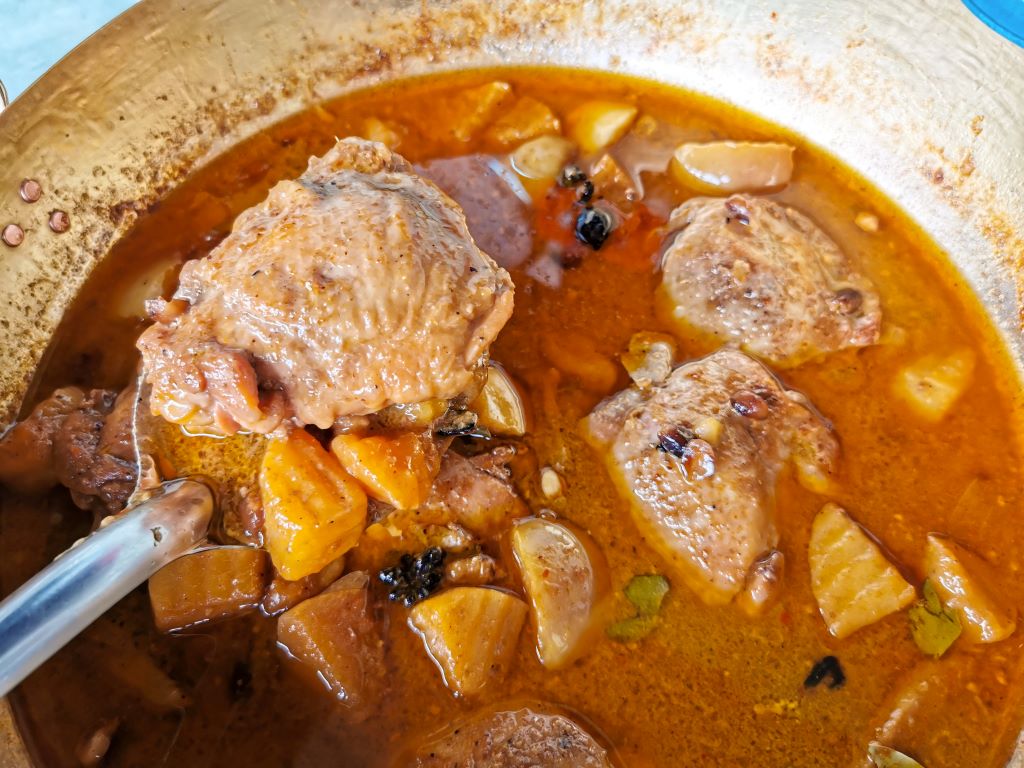
A Thai staple, Massaman Gai has won fans around the world for its calm profile and its tantalizing mixture of spices that make it a little unique amongst Thai cuisine.
The word Massaman is thought to come from the word Muslim. One story ties the curry to a variety made by a Persian merchant, which became popular amongst the nobility in the capital.
Another gives a broader origin, telling of how the ingredients that make Massaman distinct (cardamom, cumin, cinnamon, bay leaves, and anise among others) were brought from the subcontinent by predominately Muslim traders and gradually mixed themselves into Thai culture. These spices, along with coconut milk and cream, mellow the heat of the chilies to make a milder (but no less fragrant) dish than what you might be used to, something that explains its popularity in the West.
Only after the sauce has been properly mixed does the meat come.
Considering its Muslim origins, Massaman is rarely made with pork, with Thais opting instead for chicken, beef, lamb, or mutton. After that onions, potatoes, and peanuts along with additional flavor enhancers like tamarind paste and fish sauce are added.
Though bulked up by the potatoes, Massaman is usually served with a side of rice, making a solid meal for the weary traveler. Massaman Gai is often rated as one of the best dishes in the world and is a staple of Thai street stalls.
A mouthful of rich Massaman is a taste of the richness of Thailand, a true blend of the various cultures and traditions that makes it so unique.
Moo Ping

Grilled pork on skewers is a familiar dish to westerners when it is in the form of stay sticks (see below).
Moo Ping is a favorite street stall addition in Thailand because of the tangy marinade. Garlic, coriander, peppercorns, fish sauce, and soy sauce are the key ingredients in the marinade. The thinly sliced pork is pushed onto the skewers until it seems impossible to fit any more meat on them! Then they are quickly cooked over burning coals until the pork is nicely caramelized.
As if this snack couldn't get any better, coconut milk is brushed on the moo ping as it's cooking to seal the meat. Cheap, fast, fresh, and tasty – the essence of Thai cooking!
Moo Satay (Pork Satay)

Foreigners are probably used to Thai satays made from chicken breast, but pork satay (served in skewers like souvlaki) is part of Thai street food that is delectable as it is integral.
Both Thailand and Malaysia claim satay as their own, but some historians say it's actually more likely to have originated in Java, influenced by Indian and Arab traders who flocked there during the 17th Century.
Wherever it comes from the Moo Satay you'll see on the streets comprises thinly sliced pork, marinated in coconut milk, and a number of Thai spices including turmeric, coriander, and chili. The pork is then impaled on sticks before being grilled on the street, usually over hot coals.
Vital to the skewers themselves is the dipping sauce that accompanies them, a sweet (although not sickly) peanut sauce typically mixed with red curry paste.
A cucumber and onion relish called "ajad" also plays a key role in turning your meat skewer into a whole new world of flavor.
Moo Satay can be served alongside rice but rarely are. Instead, it's far more common to see tourists and locals eating these delicious sticks by the dozen. Possibly Asia's best lunchtime snack!
Nam Tok Neua (Beef Waterfall Salad)

This unusually named dish is from the Isaan region of northeastern Thailand. "Nam Tok" means waterfall.
It is a close cousin to that other popular dish in Isaan, Laab. Like Laab, this Isaan salad uses the flavorings of lime juice, chili, and fish sauce. But whereas Laab is made from raw or cooked mince, Nam Tok Neua is made from grilled beef. The beef is marinated in light soy sauce and peppercorns before placing on a sizzling hot grill. It is then thinly sliced and mixed with the other ingredients and topped with cilantro, mint leaves, and shallots.
The dish is quite dry when served in northern Thailand and it is often served with sticky rice.
Pad Kra Pao
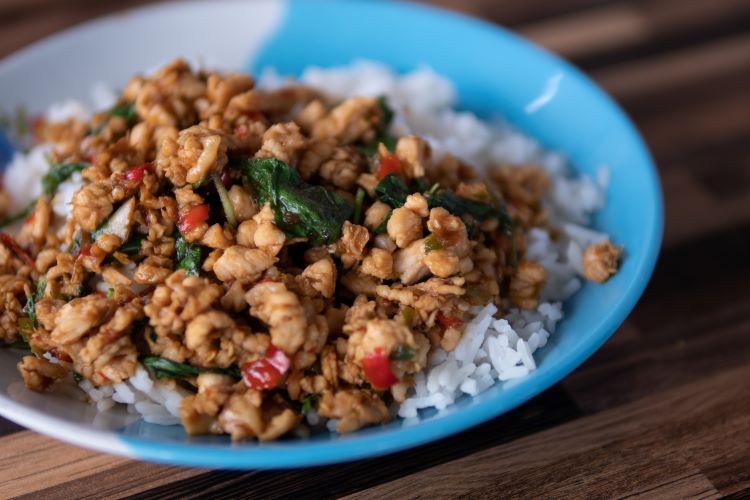
This is a firm favorite in my house for a quick and authentic Thai meal. It just doesn't feel as fresh as when bought from a Bangkok food stall!
Pad Kra Pao is stir-fried chicken with holy basil. You can find it in Thailand with either minced pork or chicken as the main ingredient. The sauce is made from oyster sauce and light and dark soy sauce but the star of this quick dish is the holy basil. In Thailand, you can find regular basil, lemon basil, and holy basil.
Stirred in after the chicken has been quickly cooked and the sauce added, the holy basil makes this dish scream "Thailand"!
Pad See Eiw

Pad See Ew is a dish of Chinese origin (or at least inspiration) and one you might have heard of in your local area.
Pad See Ew can be found in Thai restaurants across the world, but of course, there's nothing quite like sampling Thai cuisine in its place of origin: the streets of Thailand itself. Similar to the Char Kway Teow of Malaysia and Singapore, Pad See Ew is a stir-fried noodle dish in which soy sauce is (understandably) very prominent.
Pad See Ew uses wide flat noodles made from rice that is known in Thailand as "sen yai", along with green leafy vegetables like Pak Kana and Chinese broccoli.
The sauce itself looks fairly simple, but often ingeniously uses different types of soy sauce to achieve different effects on different ingredients. Garlic and chili are of course added for flavor. Pad See Ew can go with all kinds of sliced meat but is usually made with chicken or pork. Vegetarian varieties or versions that incorporate seafood or also widely available.
A wholesome and filling dish, Pad See Ew is a great staple meal to sit down and eat with your fellow travelers, providing you with all the fuel you need on your adventures throughout the country.
Pad Thai

The dish that most people on their first trip to Thailand can't wait to try is this wok-fried masterpiece.
Although you probably have had your fill of this dish at your local Thai restaurant back home, the versions awaiting you in Bangkok are wildly complex and a perfect balancing act of sweet and sour.
Pad Thai actually has its roots in Southern Chinese cuisine brought to Thailand by early traders from the North.
The creation of this dish is credited to the Thai Prime Minister in the 1930s as a form of Nationalism. In fact, the full name Kway Teow Pad Thai uses the Chinese name for rice noodles in its name. What makes Pad Thai in Bangkok so incredible is the way that vendors cook the dish in an extremely hot wok.
This high heat cooking sears the tofu and plumps the shrimp while caramelizing the noodles in the sauce. This is where the balancing act of sourness from tamarind and the sweetness of palm sugar takes place that separates the best street vendors from the rest. The dish is completed in waves with the seasoning being next in line. Fish sauce, dried shrimp, and preserved daikon are added to bring not only a salty pop but also add a funky backbone of umami. The last piece is the garnishing of the fresh ingredients including bean sprouts, garlic chives, peanuts, limes, and occasionally banana blossoms. If you like it spicy, sprinkle a little Prik Pon (dried Thai chili flakes), but be careful as these chilies are Thai hot!
Where to try it: Pad Thai Saladang, Silom Bangkok
by Kristel and Gabriel from Chef Travel Guide
Pla Muek Yang (Thai Charred Squid)

Thailand, particularly it's south, is a coastal country, with the narrow Kra Isthmus being surrounded by the Andaman Sea on one side and the Pacific's Gulf of Thailand on the other.
It's no surprise then that seafood is well integrated into Thai cuisines, and one of the most common examples of this is Pla Muek Yang.
Doused in a sweet and sour sauce comprising sugar, lime juice, fish sauce, chili, and garlic, this locally caught squid is then mounted upon wooden skewers before being chargrilled to perfection in markets and along roadsides across the country. Pla Muek Yang is versatile, and the skewers can stand alone as appetizers or quick snacks, or come topped with garnishing like peanuts and shallot and served in a salad.
It's often also dipped in chili sauce before eating, making for a brisk and fresh snack perfect for your travels along Thailand's long, meandering coastline.
Poh Pia Tod (Spring Rolls)
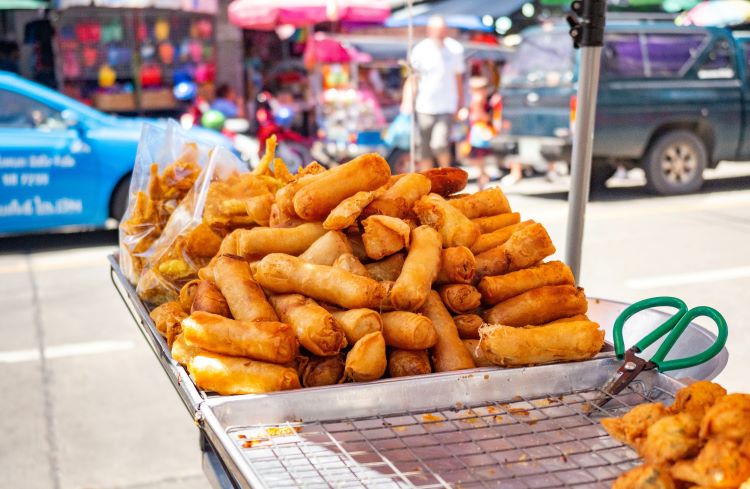
The humble spring roll has been a household name in the West for decades and it's also amongst the most popular street food in Thailand.
Poh Pia Tod has its origins in 17th Century Southern China, in the provinces of Fujian and Chaozhou.
The name comes from the word "po̍h-piá" meaning "thin wafer" in the Chahoshan dialect and is thought by some to have migrated into Thailand relatively recently via way of Vietnam.
If you come across a spring roll vendor you can expect to see lengths of rice (or sometimes wheat) paper cut up before your eyes into bite-sized segments.
These are in turn filled with a variety of different ingredients including various Thai street meats (such as chicken, pork, and beef) and vegetables (including mung beans, Asian cabbage, carrot, and spring onion).
This mixture often also includes garlic and soy sauce and the ubiquitous chili. Once filled, the Poh Pia Tod is rolled up into a number of small cylinders and deep-fried in batches.
There's little in Thailand that's cheaper, quick, and satisfying than some Poh Pia Tod, though keep in mind there's a non-fried version, Pa Pia Tod, for those of us who have their health in mind.
Roti
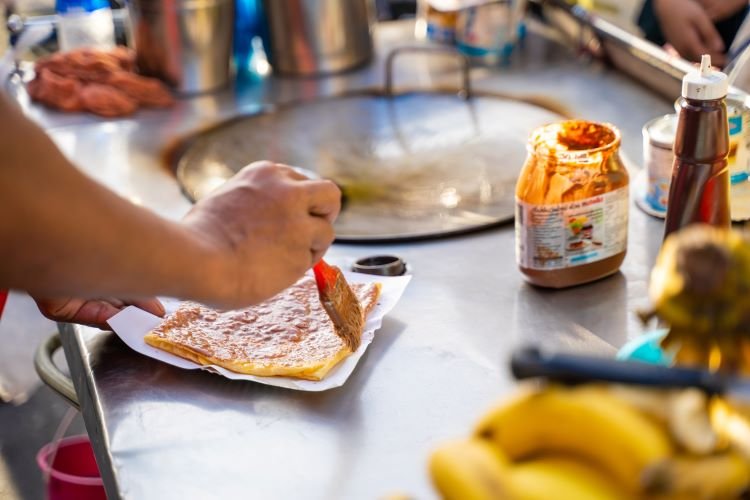
Hailing from the subcontinent and familiar to many of us across the world, the roti is relatively a new arrival upon the Thai street food scene.
Brought to Thailand by South Asian immigrant vendors, over the decades, however, this simple snack has established itself across the country.
However, unlike its relatives across the Bay of Bengal, Thai roti is not typically served as a side to curry, but as a sweet bread-based dessert that appeals to foreigners desiring something a little more familiar.
The making of roti is one of those things that looks simple to learn but takes decades to master, and many roti vendors have made the quick and flashy preparation of roti into an art form.
A simple dough mixture is quickly pan-fried into a flatbread over gentle heat. Once cooked, the roti can be finished off with a range of toppings including sweetened milk, white sugar, chocolate, and banana. Roti can be found across the country but is most common in the more Muslim south, where a savory variety known as roti mataba can also be found served with curry.
Whether you take roti in its sweet or savory forms, it's definitely worth a try. You'll see why locals and visitors alike will queue up around the block for a taste of this brazen newcomer to Thai streets.
Som Tam (Green Papaya Salad)
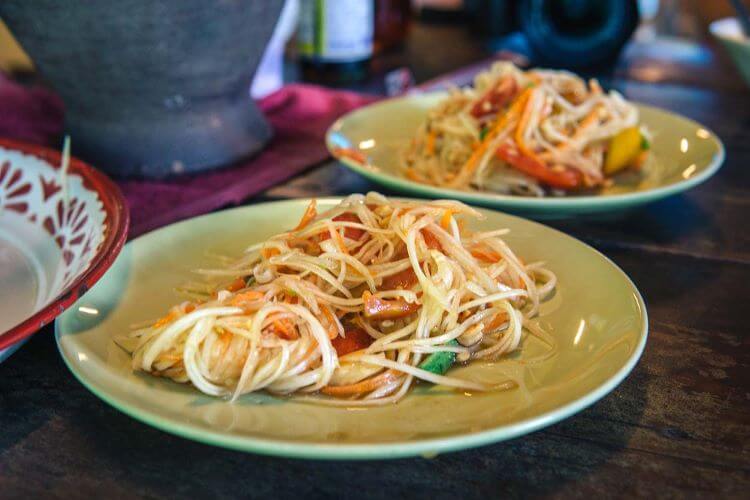
Som Tam (or papaya salad) is a deliciously zingy, fiery, and refreshing dish that encompasses all of the tastes of sweet, spicy, salty, and sour. This popular Thai food is widely found in restaurants and street stalls across Thailand with each region of the country having a slightly different version.
The more traditional Thai street food version is made from shredded unripe papaya (which gives it a crunchy texture). The papaya is combined with a mix of chilies, fresh garlic, dried shrimp, fish sauce, sweet palm sugar, peanuts, and lime juice, then tossed with cherry tomato halves and chopped green long beans.
It is a very quick dish to prepare and all the ingredients are pounded together in a clay mortar with a wooden pestle (tam means pounded in Thai). Som Tam is almost always served with sticky rice and usually accompanied by either fish, crab, or BBQ chicken.
We also tried a lovely version of som tam whilst taking part in a Chiang Mai cooking class, and many cooking schools across Thailand offer classes on how to prepare this dish from scratch.
Alternatively, you won't have any trouble finding this in shopping centers food courts such as MBK center and Terminal 21, or at roadside street food stalls in downtown Bangkok. It is usually a VERY spicy dish so if you want to order a tamer version remember to point at the pile of chilies and say nit-noi (a little bit!)
Tom Kha Gai (Chicken Galangal Soup)

Tom Kha Gai gets its distinctness from the galangal (Kha), a zingy rhizomatic plant related to ginger, although significantly milder in taste. Tom Kha Gai is one of Thailand's more well-known soups and has come to be somewhat recognized in the West.
Like other such dishes, it probably owes this renown to its mild and creamy taste that balances the winning spice profile of Thai cuisine (as always, fish sauce and chili) with the always mellowing effect of coconut milk. Also, the key to Tom Kha Gai's winning mixture is the strong element of citrus that cuts through the cream, the soup usually being served with a generous squeeze of lime juice and the chopped stalks of lemongrass. Mushrooms, typically smaller Asian varieties such as straw or shitake, are added to give the soup more substance, while some street cooks will go so far as to include innards and congealed blood into the mix.
Should that scare you, there are many other versions of Tom Kha. Some are served with seafood and pork while others are vegan-friendly options that concentrate on the mushrooms or simply replace the meat with tofu.
This warming and above all versatile soup is one of the best Thailand has to offer.
Pak Boong Fai Deng (Morning Glory over Red Flame)
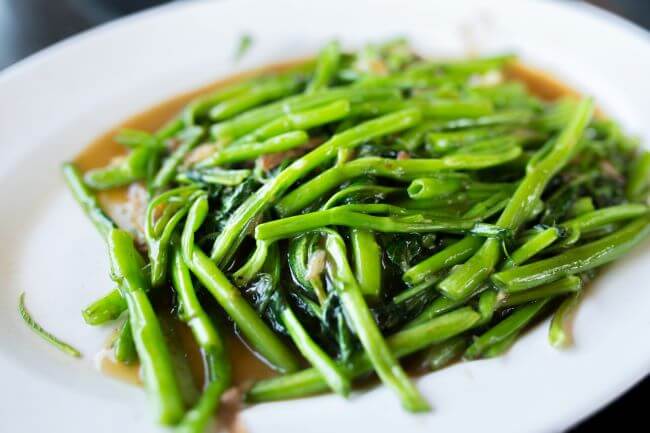
Pak Boong Fai Deng's key ingredients are something you're more likely to associate with your garden: it's made from a variety of the flowering plant (and sometimes noxious weed) morning glory.
Also known as water spinach, this semi-aquatic plant is a key part of many South-East Asian cuisines and is valued for its unique (and hard to describe) cacophony of flavors.
Making Pak Boong Fai Deng is devilishly simple and quick. Your friendly Thai street vendor will simply take a handful of plucked morning glory leaves and garnish it with fish sauce, garlic, and chili.
They'll often pour soup stock over the top before the real fun begins. The mix is dropped into a red-hot wok, inciting tongues of flame to shoot up into the air. The leafy blend is tossed a few times (often very dramatically) before being served onto a plate, not five minutes after the order has left your mouth.
It's the process that provides the end of the dish's name "fai deng", referring to the leaping red flame that shoots up, much to the delight of startled tourists.
Sai Krok Isan (Thai Sausage)

One of the more common sights at Thailand Street Food stalls are Isaan sausages, often found in mobile carts pulled up at the roadside, and surrounded by plumes of smoke (not to be mistaken for the 'look chin' which are deep-fried and only made tasty with a sticky chili sauce).
Isaan sausages originated from the Northeastern region of Thailand (Isaan) where they are a staple at every street food or food market where sausages are strung ready to be cooked over charcoal grills.
The most common version of sausage would use pork that has been fermented (a bit like naem) mixed with sticky rice and garlic, and it has a unique sour flavor. A filling sausage that is delicious on its own but on a whole new level when wrapped in a cabbage leaf along with green chilies and cuts of pickled ginger, together creating an explosion of intense signature Thai flavors. These are at least the common oblong-shaped sausages found at Bangkok street food stalls. Occasionally though they are found sold as smaller ball-shaped sausages, and may be served with a variation of 'nam jim' chili dips.
But almost always they will be served in a small plastic bag and skewer stick making them easy to eat on the go from Thai Street Food stalls. There is also a more obscure variation known as 'mum' which is found almost specific to Isaan with sausages made from beef.
Otherwise, Isaan sausages can be hard to find indoors and on restaurant menus, but a great local chain to find them is Som Tam Nua.
by Allan Wilson at Live Less Ordinary
Tod Mun Pla (Deep Fried Fish Cakes)
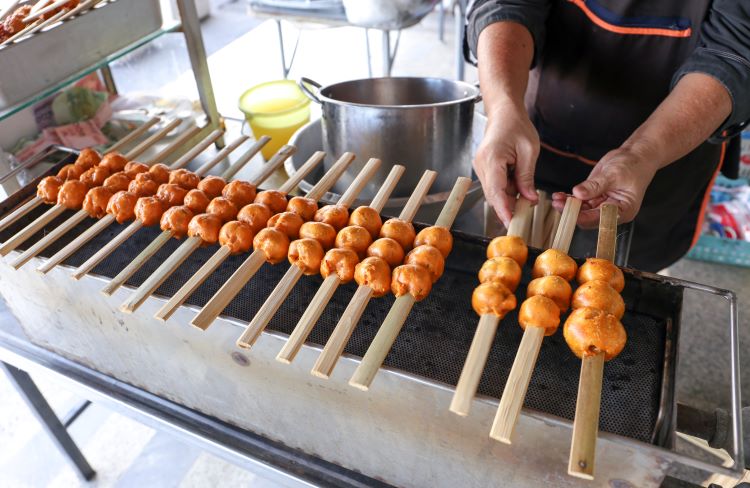
A classic recipe so old that its origin is clouded in the mists of time, Tod Mun Pla is a variety of deep-fried Thai fish cakes that you can remind yourself is a great source of lean protein.
A crowd favorite, you'll find Tod Mun Pla all around Thailand's expansive coast as well as in the inner regions, though every vendor is sure to have their own twist. The fish paste (usually made from local fish like Clown featherback or Pla Grai), red curry paste, fresh lime juice, basil leaves, and various spices are mixed up into a fragrant blend before being dropped into a wok full of hot oil.
Here they begin to grow and expand, fluffing up into balls before settling once more on the customer's plate. Both spicey and chewy, Tod Mun Pla often serves as an appetizer or quick snack, but can also form the basis of a hearty meal if accompanied by rice and fresh vegetables.
Perhaps a little healthier than many of the quicker options on the street, Tod Mun Pla offers something distinctly authentic to the traveler, with all the deep satisfaction that accompanies deep-fried food.
Tom Yum Goong (Hot Shrimp Soup)

Believed to originate from Thailand's rural center, Tom Yum Goong (or Tom Yum Noodle Soup) is a hot soup whose key ingredient is shrimp.
Some experts tie its development to the Chao Phraya River, known for its abundance of freshwater shrimp and it has since become a favorite in Thailand and across the world.
The soup broth generously combines the citrus of kaffir lime leaves, lemongrass and lime juice with the zing of galangal, the heat of chili, and the salty aquatic flavors of fish sauce and the shrimp themselves. The effect is a spicy, salty, and sour flavor that pairs perfectly with the more neutral flesh of the shrimp.
But if you're not a fan of seafood, there are many other different varieties of Tom Yum including Tom Yum Gai (made with chicken) and Tom Yum Moo (made with pork) as well as a variant that includes coconut milk and centers galangal as the dominant spice.
Whichever variety takes your fancy, you're sure to find out why this humble little soup has become an international favorite.
Further Resources
- Get Your Guide Thailand travel activities are here
- Planning a trip to Thailand? Read about the Khmer Empire's most important outpost, Phimai, here.
- If you love reading about culture and food, especially in Asia, check out all of my articles about Culture Through Food.
- See all of my articles on Thailand here and Asia here
- More detailed information on how to book transport, airfares, accommodation, and travel insurance is available on my Travel Resources page .
More articles for you about Thailand and Cambodia
Source: https://tripanthropologist.com/thai-street-foods/
0 Response to "Thai Woman Street Food Ad Funny"
إرسال تعليق